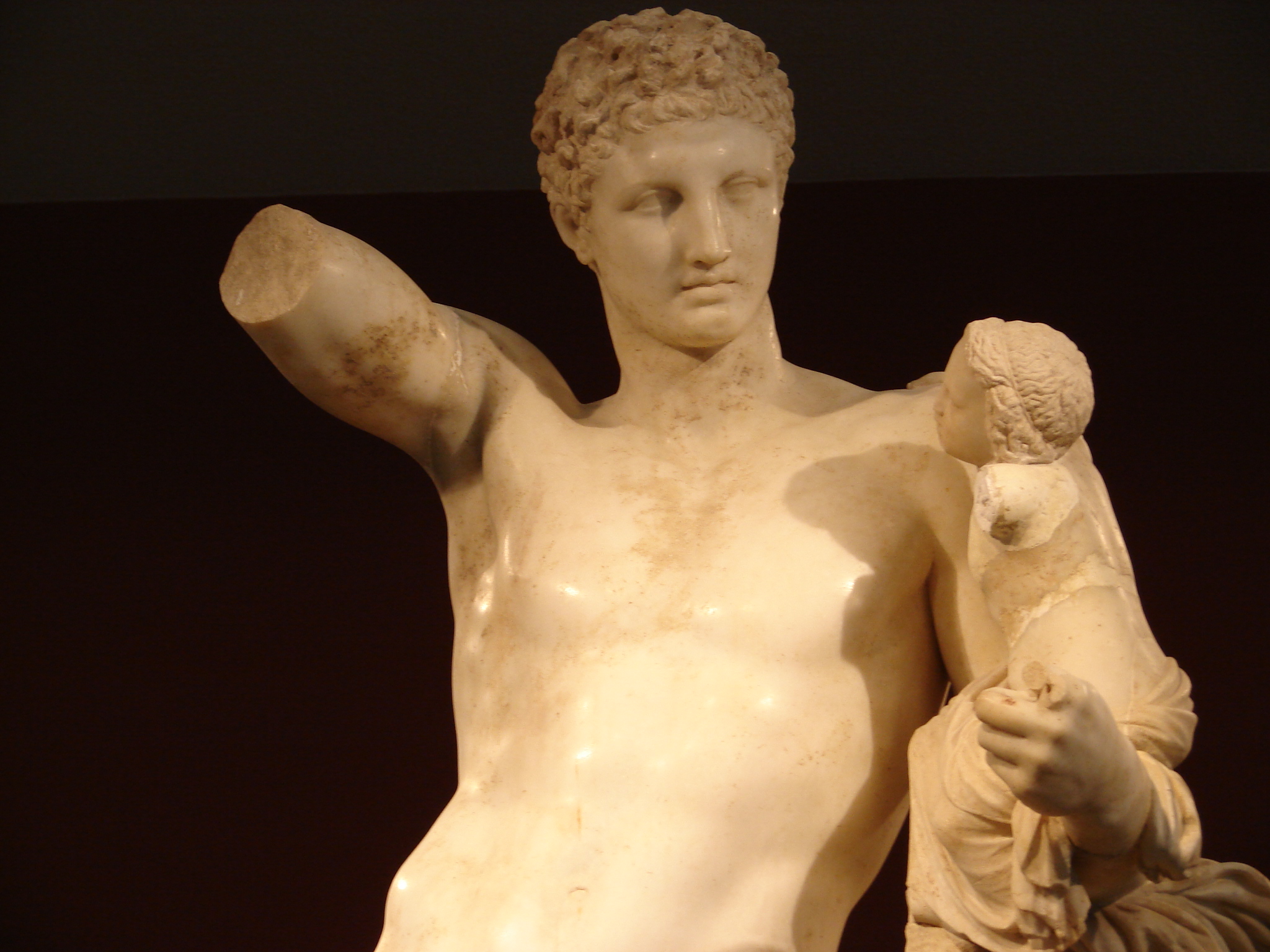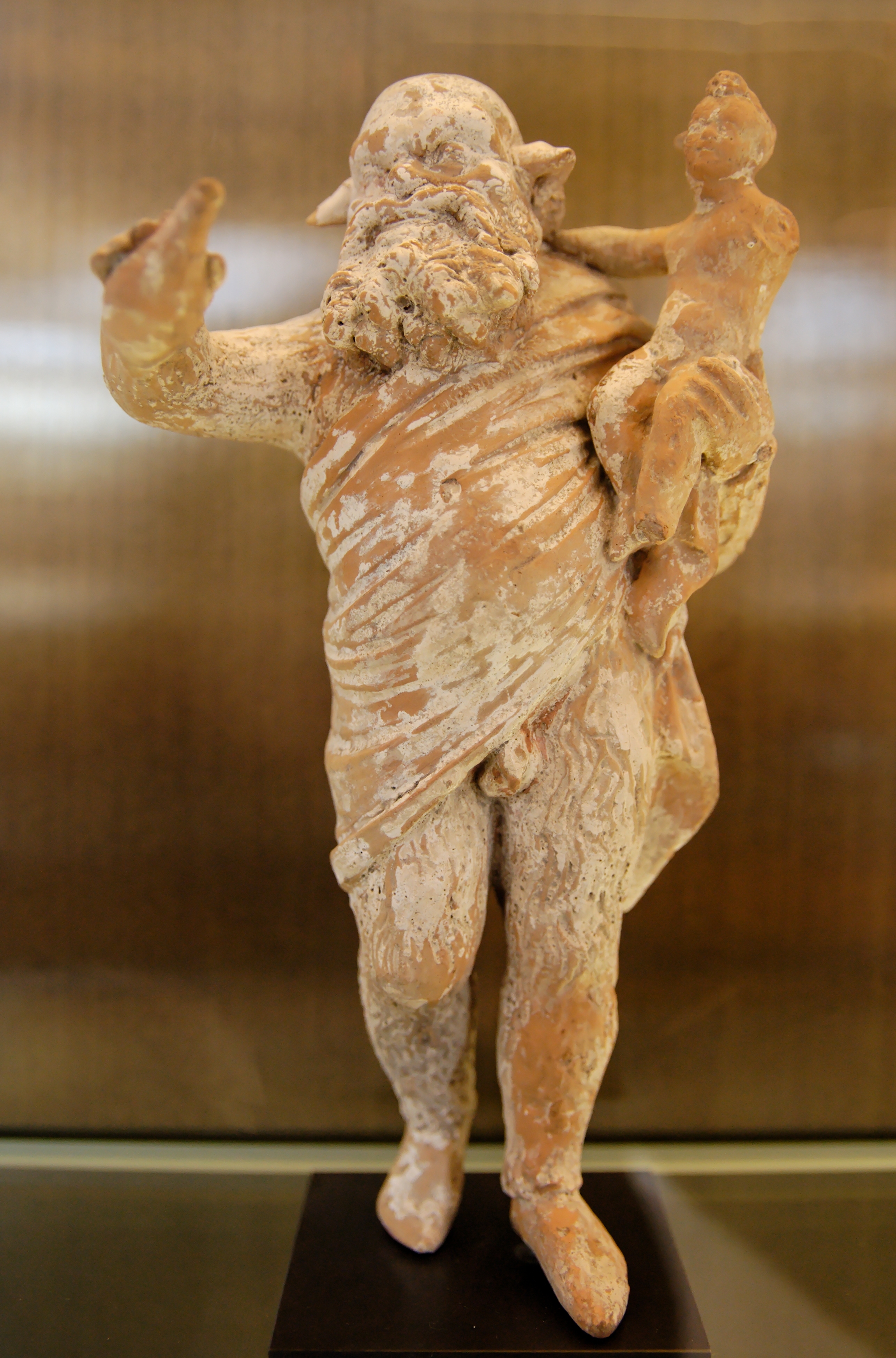Hermes and the Infant Dionysos on:
[Wikipedia]
[Google]
[Amazon]
 ''Hermes and the Infant Dionysus'', also known as the ''Hermes of Praxiteles'' or the ''Hermes of Olympia'' is an
''Hermes and the Infant Dionysus'', also known as the ''Hermes of Praxiteles'' or the ''Hermes of Olympia'' is an
 It took six more separate discoveries to uncover the rest of the statue as it is displayed today. Hermes is still missing his right forearm, two fingers of his left hand, both forearms below the elbow, the left foot and his penis, whilst Dionysus is missing his arms (except the right hand on Hermes's shoulder) and the end of his right foot. Much of the tree trunk and the plinth are also lost. However, an ancient base survives, made of a grey limestone block between two blocks of marble.
It took six more separate discoveries to uncover the rest of the statue as it is displayed today. Hermes is still missing his right forearm, two fingers of his left hand, both forearms below the elbow, the left foot and his penis, whilst Dionysus is missing his arms (except the right hand on Hermes's shoulder) and the end of his right foot. Much of the tree trunk and the plinth are also lost. However, an ancient base survives, made of a grey limestone block between two blocks of marble.


Dossier : Praxitèle, un maître de la sculpture antique
Musée du Louvre {{DEFAULTSORT:Hermes And The Infant Dionysus 4th-century BC Greek sculptures Archaeological discoveries in Greece Hellenistic sculpture Nude sculptures in Greece Sculptures by Praxiteles Sculptures of Dionysus Sculptures of Hermes Sculptures of children 1877 archaeological discoveries
 ''Hermes and the Infant Dionysus'', also known as the ''Hermes of Praxiteles'' or the ''Hermes of Olympia'' is an
''Hermes and the Infant Dionysus'', also known as the ''Hermes of Praxiteles'' or the ''Hermes of Olympia'' is an ancient Greek sculpture
The sculpture of ancient Greece is the main surviving type of fine ancient Greek art as, with the exception of painted ancient Greek pottery, almost no ancient Greek painting survives. Modern scholarship identifies three major stages in monument ...
of Hermes
Hermes (; grc-gre, Ἑρμῆς) is an Olympian deity in ancient Greek religion and mythology. Hermes is considered the herald of the gods. He is also considered the protector of human heralds, travellers, thieves, merchants, and orat ...
and the infant Dionysus
In ancient Greek religion and Greek mythology, myth, Dionysus (; grc, wikt:Διόνυσος, Διόνυσος ) is the god of the grape-harvest, winemaking, orchards and fruit, vegetation, fertility, insanity, ritual madness, religious ecstas ...
discovered in 1877 in the ruins of the Temple of Hera, Olympia
The Temple of Hera, or Heraion, is an ancient Archaic Greek temple at Olympia, Greece, that was dedicated to Hera, queen of the Greek gods. It was the oldest temple at Olympia and one of the most venerable in all Greece. It was originally a ...
, in Greece. It is displayed at the Archaeological Museum of Olympia
The Archaeological Museum of Olympia (Greek: Αρχαιολογικό Μουσείο Ολυμπίας) is one of the principal museums of Greece, located in Olympia. It is overseen by the Ministry of Culture and Sports, and, as of 2009, is direc ...
.
It is traditionally attributed to Praxiteles
Praxiteles (; el, Πραξιτέλης) of Athens, the son of Cephisodotus the Elder, was the most renowned of the Attica sculptors of the 4th century BC. He was the first to sculpt the nude female form in a life-size statue. While no indubita ...
and dated to the 4th century BC, based on a remark by the 2nd century Greek traveller Pausanias Pausanias ( el, Παυσανίας) may refer to:
*Pausanias of Athens, lover of the poet Agathon and a character in Plato's ''Symposium''
*Pausanias the Regent, Spartan general and regent of the 5th century BC
* Pausanias of Sicily, physician of t ...
, and has made a major contribution to the definition of Praxitelean style. Its attribution is, however, the object of fierce controversy among art historians.
The sculpture is unlikely to have been one of Praxiteles' famous works, as no ancient replicas of it have been identified. The documentary evidence associating the work with Praxiteles is based on a passing mention by the 2nd century AD traveller Pausanias Pausanias ( el, Παυσανίας) may refer to:
*Pausanias of Athens, lover of the poet Agathon and a character in Plato's ''Symposium''
*Pausanias the Regent, Spartan general and regent of the 5th century BC
* Pausanias of Sicily, physician of t ...
.
Loss
The Olympia site was hit by an earthquake during the reign of the Roman emperorDiocletian
Diocletian (; la, Gaius Aurelius Valerius Diocletianus, grc, Διοκλητιανός, Diokletianós; c. 242/245 – 311/312), nicknamed ''Iovius'', was Roman emperor from 284 until his abdication in 305. He was born Gaius Valerius Diocles ...
in the final years of the third century C.E, collapsing the roof of the Temple of Hera and burying the statue in rubble.
Rediscovery
In 1874, the Greek state signed an agreement with Germany for an archaeological exploration of the Olympia site, which was first dug in the FrenchMorea expedition
The Morea expedition (french: link=no, Expédition de Morée) is the name given to the land intervention of the French Army in the PeloponneseMorea is the name of the Peloponnese region in Greece, which was mainly used from the medieval per ...
of 1829. The German excavations in 1875 were led by Ernst Curtius
Ernst Curtius (; 2 September 181411 July 1896) was a German archaeologist, historian and museum director.
Biography
He was born in Lübeck. On completing his university studies he was chosen by C. A. Brandis to accompany him on a journey to ...
. On 8 May 1877, in the temple of Hera, he uncovered the body (head, torso, legs, left arm) of a statue of a young man resting against a tree trunk covered by a mantle. Protected by the thick clay layer above it, it was in an exceptionally good state of preservation.
 It took six more separate discoveries to uncover the rest of the statue as it is displayed today. Hermes is still missing his right forearm, two fingers of his left hand, both forearms below the elbow, the left foot and his penis, whilst Dionysus is missing his arms (except the right hand on Hermes's shoulder) and the end of his right foot. Much of the tree trunk and the plinth are also lost. However, an ancient base survives, made of a grey limestone block between two blocks of marble.
It took six more separate discoveries to uncover the rest of the statue as it is displayed today. Hermes is still missing his right forearm, two fingers of his left hand, both forearms below the elbow, the left foot and his penis, whilst Dionysus is missing his arms (except the right hand on Hermes's shoulder) and the end of his right foot. Much of the tree trunk and the plinth are also lost. However, an ancient base survives, made of a grey limestone block between two blocks of marble.
Technical considerations
The group is sculpted from a block of the best quality ofParian marble
Parian marble is a fine-grained semi translucent pure-white and entirely flawless marble quarried during the classical era on the Greek island of Paros in the Aegean Sea.
It was highly prized by ancient Greeks for making sculptures. Some of the ...
. Hermes measures 2.10/2.12 m, 3.70 m with the base. The right foot of Hermes is integral with a section of the base, which has undergone some adjustment in antiquity.
The face and torso of Hermes are striking for their highly polished, glowing surface, which John Boardman half-jokingly attributed to generations of female temple workers. The back, by contrast, shows the marks of the rasp and chisel, and the rest of the sculpture is incompletely finished.
At the time of its discovery, the hair retained slight traces of cinnabar
Cinnabar (), or cinnabarite (), from the grc, κιννάβαρι (), is the bright scarlet to brick-red form of mercury(II) sulfide (HgS). It is the most common source ore for refining elemental mercury and is the historic source for the bri ...
, a form of mercury sulfate with a red color, perhaps a preparation for gilding. Cinnabar tints are retained on the sandal straps of the original foot, with traces of gilding. The sandal also bears the motif of a Heraclean knot, which was probably extended in paint.


Popular culture
*The statue is present in the 2016 anime '' Sekko Boys''.Notes
Bibliography
* Aileen Ajootian, "Praxiteles", ''Personal Styles in Greek Sculpture'' (Olga Palagia
Olga Palagia is Professor of Classical Archaeology at the National and Kapodistrian University of Athens and is a leading expert on ancient Greek sculpture. She is known in particular for her work on sculpture in ancient Athens and has edited a ...
& Jerome J. Pollitt, ed.s), Cambridge University Press, 1998 (1st edition 1996) , p. 103-110.
* Rhys Carpenter, "Two Postscripts to the Hermes Controversy", ''American Journal of Archaeology'' (January 1954) vol. 58, issue 1, p. 1-12.
* Alain Pasquier :
** " L’''Hermès'' d'Olympie », dans ''Olympie'', actes d'un cycle de conférences organisé au musée du Louvre du 18 janvier au 15 mars 1999, Documentation française, Paris, 2001, , p. 243-271.
** " Praxitèle aujourd'hui ? La question des originaux », dans ''Praxitèle'', catalogue de l'exposition au musée du Louvre, 23 mars-18 juin 2007, éditions du Louvre & Somogy, 2007, , p. 97-103 et p.&120-122.
* Gisela M. A. Richter, "The Hermes of Praxiteles", ''American Journal of Archaeology'' (July–September 1931) vol. 35, issue 3, p. 277-290.
* Brunilde Sismondo Ridgway, ''Fourth-Century Styles in Greek Sculpture'', University of Wisconsin Press, Madison, 1997 ()
* Claude Rolley
Claude Rolley (11 November 1933, Saint-Lô (Manche) – 10 February 2007) was a French archaeologist, ''emeritus'' at the University of Burgundy, writer on art, archaeology of Greece and Gaule.
Selected publications
* « Une amphore inédite du ...
, ''La Sculpture grecque, vol. II : La période classique, Picard, Manuels d'art et d'archéologie antiques'', 1999 (), p. 250-254.
* Georg Treu
Georg Treu (29 March 1843 (Old Style, OS), Saint Petersburg – 5 October 1921, Dresden) was a Classical archaeology, Classical archaeologist and curator of the sculpture collection at the Albertinum.
Life
He began as a theology student at the ...
, ''Hermes mit dem Dionysosknaben: ein Originalwerk des Praxiteles gefunden im Heraion zu Olympia'', Wasmuth, Berlin, 1878.
External links
* *Dossier : Praxitèle, un maître de la sculpture antique
Musée du Louvre {{DEFAULTSORT:Hermes And The Infant Dionysus 4th-century BC Greek sculptures Archaeological discoveries in Greece Hellenistic sculpture Nude sculptures in Greece Sculptures by Praxiteles Sculptures of Dionysus Sculptures of Hermes Sculptures of children 1877 archaeological discoveries